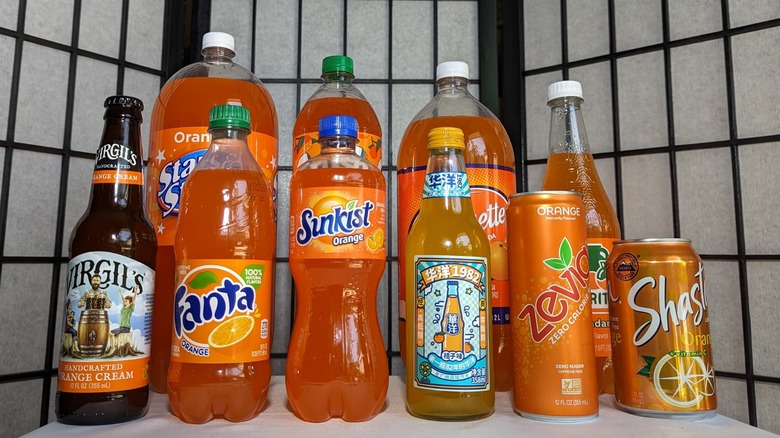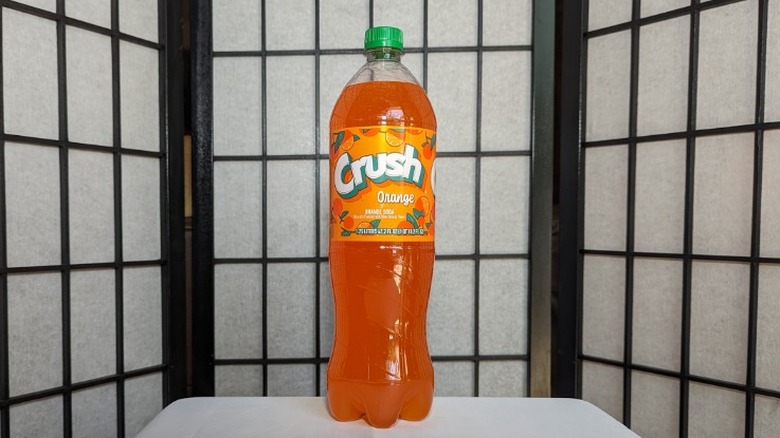9 Orange Soda Brands Ranked Worst To Best
Orange soda is a favorite beverage the world over, and the citrus drink has been one of the most popular fruit flavors of soda for years. A nice, cold orange soda can be a nostalgic treat that sparks a memory of childhood, or it can just be a refreshing drink on a warm day.
One of the earliest commercially available orange sodas was created in Los Angeles by chemist Neil C. Ward, who called his new concoction Ward's Orange-Crush. Real orange pulp was originally in the formula for making the beverage, but it was removed after 1930. While the recipes have changed over the years, fizzy orange drinks have proliferated and are available almost anywhere drinks are sold. Dozens of brands have sprung up from all corners of the globe, and many of them are likely available at your local market.
Deciding which one is best will always be an exercise in subjectivity, but taking into account a few objective parameters, we can attempt to ascertain which labels you should be enjoying next. Barring any diet drinks sweetened with artificial sweeteners, here are 9 orange sodas ranked from worst to best.
9. Stars and Stripes
For this taste test, the clear winner of the losing slot was the orange soda known as Stars and Stripes, available exclusively from Dollar Tree. This drink is by far the best value, with a 2.75-liter bottle costing just $1.25. It is also the largest available, offering nearly a liter more than the standard 2-liter soda bottle.
However, with the budget price comes a budget taste. It is interesting to note that despite being a non-diet soda with plenty of calories, the artificial sweeteners aspartame and acesulfame potassium are listed in the ingredients. Perhaps this makes it cheaper to produce. High fructose corn syrup (HFCS) is still one of the main ingredients and contributes to its typically high calorie count. This might be why the drink is very sweet but also has an unnatural aftertaste reminiscent of many diet drinks. Overall the flavor tastes unnatural and only nominally orange. It is generally just not good.
8. Shasta Orange
Shasta is commonly found on store shelves as a budget alternative to name-brand drinks but is also a regular feature in hospitals — many people may remember having small cans of Shasta lemon-lime soda during a hospital stay. Outside of medical settings, Shasta is sold in cans and 2-liter bottles, and Dollar Tree sells 4-packs for just $1.25. So it is a genuine bargain.
The flavor of Shasta Orange falls heavily on the sweet side, and the carbonation is strong as well. The flavor comes off a bit flat and tastes like the orange obviously comes from artificial sources. The can lists vitamin C as an additive, but not caffeine. This drink may be a fine choice when stretching your budget for a kids' party — it is totally drinkable and enjoyable — but it probably won't be your first choice. It is not terrible, but there are better choices for just a little more money.
7. Fanta Orange
Fanta is a product of the Coca-Cola Company that is widely available, but it's not usually a first pick for most Americans. Its history is a bit murky, as it was created in Germany in the 1930s after American products, including the syrup used to make Coca-Cola, were banned from being exported to the region. Limited agricultural resources led to the soda's varieties of fruit flavoring, but all of those wartime recipes have since been revised into the options we have today.
Fanta Orange is sweet and syrupy. The orange flavor is strong but tastes more like an orange candy than the actual fruit. It has a bit of zestiness to it that does serve to balance the sweetness. This is another instance of the orange flavor tasting obviously artificial, but not necessarily in a bad way. However, the sweetness could be a turn-off for some. It is a fine orange soda with above-average taste, but only just.
6. Sunkist
The history of Sunkist stretches back to the early 20th century when a group of citrus growers banded together to form a cooperative to market their products. The group first promoted orange juice as a drink in 1916 and continued to grow with its marketing campaigns. It wasn't until 1977 that the group developed a new orange soda, which it brought to the market with the name Sunkist.
The taste of Sunkist is tangy and sweet, with obvious citrus overtones. It carries a more natural orange flavor, even though the drink contains no juice, as is indicated on the bottle. (Curiously, a group of orange growers came up with a drink that actually contains no oranges.) Sunkist is a sweet drink, and the carbonation is typical of popular colas from other major brands. One thing that sets Sunkist apart from other fruit-flavored sodas is the addition of caffeine, something few other makers put into orange soda recipes.
5. Crush Orange
The first soda to be flavored orange was called Ward's Orange-Crush, and it hit the scene in 1915 in California. The state has long been known for its citrus agriculture — oranges in particular — so it's fitting that the drink came from this area. It proved popular, as more than a thousand bottlers were distributing the beverage within a decade. The drink has changed since then and eventually became part of a large corporate beverage company, known today as Keurig Dr. Pepper.
The original Orange-Crush soda was made using real oranges in the recipe. Today the beverage is called Crush Orange, as it is one of many mostly fruit-flavored varieties produced by the Crush brand. The orange-flavored soda is good but contains no fruit juice anymore. The flavor is sweet and crisp, with less tanginess than some of its competitors. The orange flavor is more natural but still suggests the characteristics of a candy. Although it is sweet, the sweetness is not overpowering, giving it a more balanced flavor profile. Overall, it still tastes like a beverage from a major brand that relies heavily on artificial and processed ingredients, but it keeps them balanced and refreshing.
4. Zevia
While this list does not include any sodas sweetened exclusively with artificial sweeteners, there is one with zero calories: Zevia. This drink is currently one of the best-selling carbonated beverage on Amazon, and it is made from all-natural ingredients. Sweetened with stevia leaf extract, which is a sugar substitute up to 350 times sweeter than sugar, Zevia is available in 12- or 16-ounce cans in a variety of flavors, including orange.
The ingredient list is simple, including carbonated water, citric acid (vitamin C), natural flavors, and stevia leaf extract. The color of the drink is surprising: It has none. However, despite being clear, the taste of orange is unmistakable. The orange flavor is somewhat strong without overpowering the drink, and the stevia adds generous sweetness but does leave a bit of a lingering aftertaste that's similar to many diet sodas, but milder. Finally, the carbonation of Zevia is a bit more subtle than most popular sodas, giving it a mouthfeel more like some sparkling waters or seltzers.
3. Orangette
In the late '30s, a company in Arkansas developed a grape-flavored soda called Grapette, which proved to be highly popular. Building on that success, Lemonette and Orangette were added in 1946 and 1947, respectively. Grapette eventually fell out of favor, and production declined through the latter part of the 20th century. However, the brand would later be revived, and today it is an exclusive brand found only in Wal-Mart stores as one of its private labels.
Although it is a beverage with limited distribution in one chain, it competes with drinks put out by major bottlers across the country. Better still, it outperforms the competition on taste. Orangette is a sweet drink with a smooth finish that tastes more like real oranges than do other major brands. It is refreshing and the sweetness is not too heavy, while the carbonation also feels well-balanced — neither overpowering nor too flat. Best of all, at $1.18 (prices may vary) for a 2-liter bottle, it is one of the best values around.
2. Virgil's Orange Cream
Virgil's handcrafted sodas come from Reed's Inc., an independent beverage company that started business with Reed's Ginger Beer and touts its quality based on a small-batch production process that uses all-natural ingredients. Virgil's is the handcrafted-soda offshoot of Reed's, offering premium sodas made with the same all-natural ingredients in a variety of flavors. Its products are available nationwide and are commonly found in specialty and upscale supermarkets, such as Whole Foods.
The packaging is the first thing that sets Virgil's apart, with its clever and whimsical illustrations on the label. As a premium product, this soda is only available in a glass bottle, and just six ingredients are listed on the back. Aside from water, the bulk of the drink is made up of pure cane sugar. Virgil's Orange Cream is a smooth soda that hits you with a strong vanilla flavor immediately, the hallmark of a good cream soda. It is apparent the ingredients are natural and that no chemicals are trying to trick your taste buds. The flavor is full and strong, with a nice blend of cream and orange that finishes smooth with only a slight lingering vanilla. Virgil's is excellent, and the orange flavor tastes like oranges. It should be noted that, as a premium product, it is pricier than the others but probably worth it to those who appreciate a well-crafted drink.
1. Huayang 1982
To find the orange Huayang 1982, most people will need to head to a local Asian supermarket. This may not be the most popular soda in the U.S., but it is an excellent example of the high-quality products one can pick up from Asian grocery stores, and it can be fun to branch out and try things that might not be available in a typical American supermarket. Often, they can be a pleasant surprise, as is Huayang 1982 orange soda.
This drink comes from Guangzhou in southern China and is a popular drink in that region. Its flavor is markedly different from typical American sodas, and, refreshingly, tastes the most like it is made with real orange juice. It is a sweet drink, but only just, as if it was made to satisfy a sweet craving without going overboard. The carbonation is crisp and light, much like that of champagne or sparkling wine. Huayang 1982 tastes as if it would be the perfect substitute for a mimosa for someone abstaining from alcohol. While the orange flavor is excellent, Huyang 1982 also comes in a variety of other flavors such as pineapple and tangerine. The orange is a refreshing surprise, so it is probably worth it to track down a bottle.









